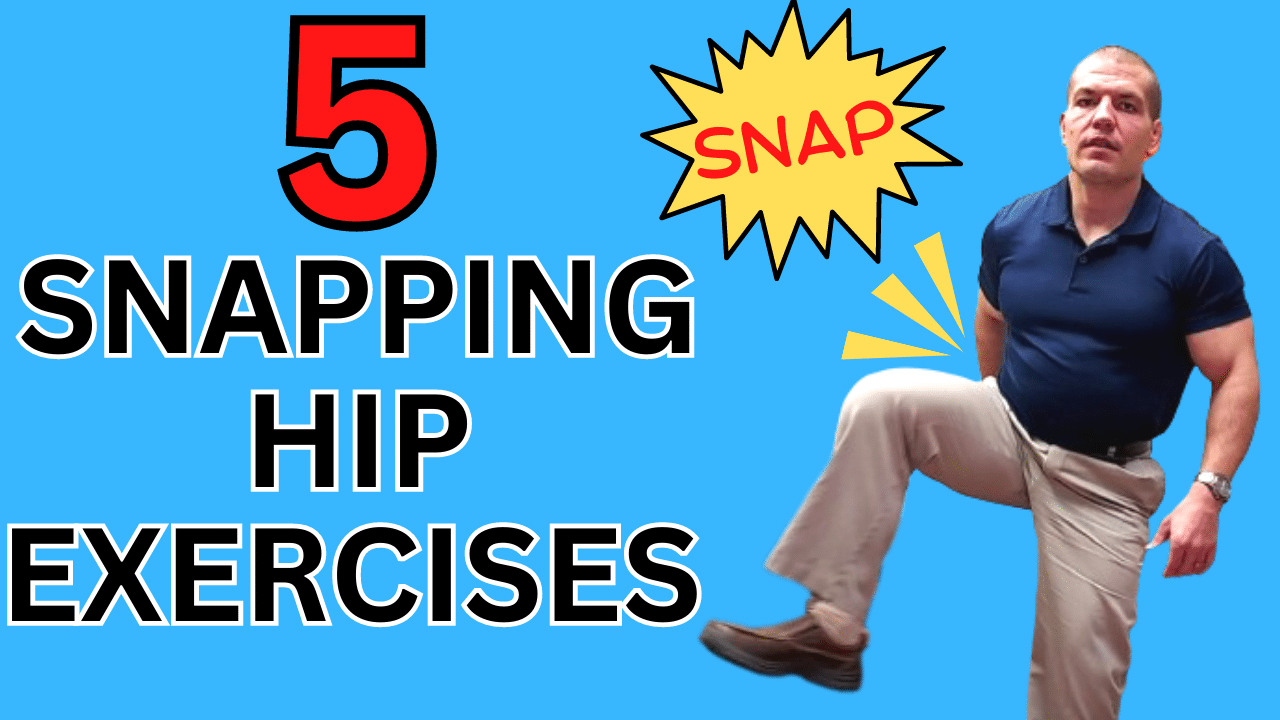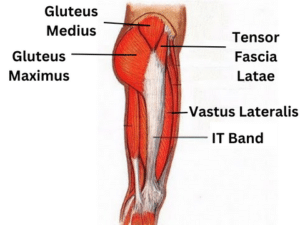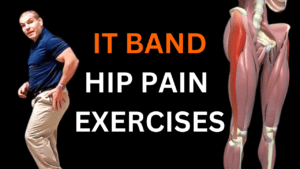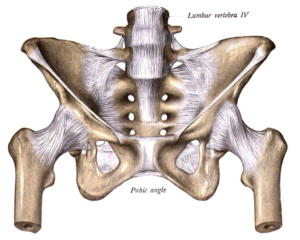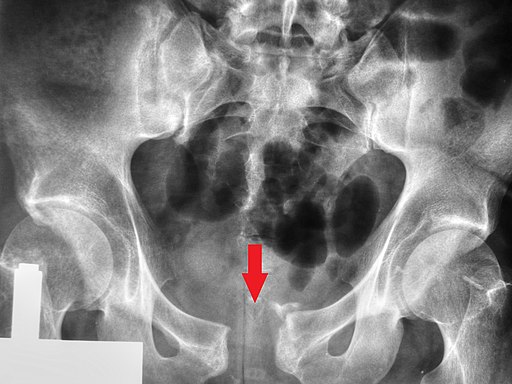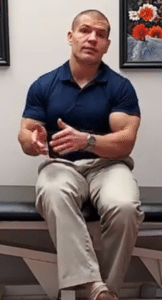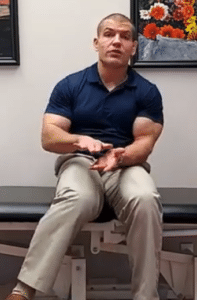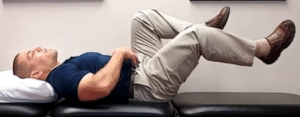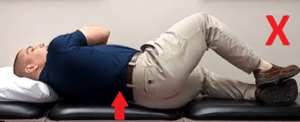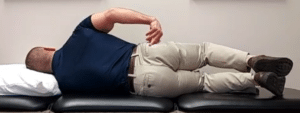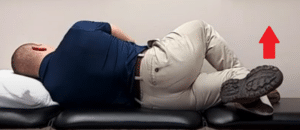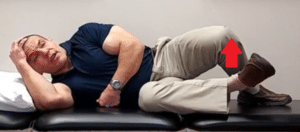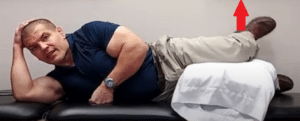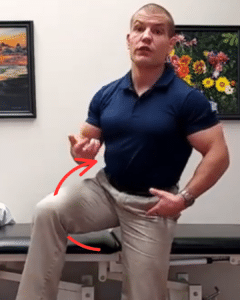What Are The Best Exercises For Snapping Hip Syndrome?
Watch the video to learn 5 snapping hip syndrome exercises to fix popping and clicking in your hip.

What Is Snapping Hip Syndrome?
Snapping hip syndrome is a condition where your hip makes a snapping, clicking, or popping sound when you move it.
About 5-10% of people have snapping hips syndrome, but usually the sound isn't painful.
Is snapping hip syndrome serious?
If there isn't any pain associated with snapping hip syndrome, it's usually not a serious problem. However, sometimes the snapping sound is just annoying, especially if it only happens on one side. It may cause you to wonder why one hip snaps or pops and the hip doesn't.
Furthermore, if there IS pain associated with snapping hip syndrome, then you definitely want to do something about it.
What Causes Snapping Hip Syndrome?
There are 2 different kinds of snapping hip syndrome, and each type of snapping hip syndrome has it's own cause.
The 2 kinds of snapping hip syndrome are:
I'll briefly describe external snapping hip syndrome first, and then the rest of this post will discuss internal snapping hip syndrome.
What Causes External Snapping Hip Syndrome?
External snapping hip syndrome is caused by the IT band running over the bone on the outside of the hip (the greater trochanter) as you exercise or otherwise move your hip.
Your IT band is basically a long tendon that runs from your hip down to your knee.
However, when the IT band crosses over the greater trochanter, it can sometime get inflamed and/or make a popping sound.
That popping sound is referred to as external snapping hip syndrome.
External Snapping Hip Syndrome Exercises
As to what exercises are best for snapping hip syndrome, I've already covered that topic in a different post about IT Band Hip Pain Exercises.
Therefore, I'll refer you to that post for more information about external snapping hip syndrome exercises.
What Causes Internal Snapping Hip Syndrome?
Internal snapping hip syndrome refers to snapping in the groin or deeper inside the hip.
There are several possible cause of internal snapping hip syndrome:
- The iliopsoas tendon running over the hip joint
- Internal hip joint pathology such as hip arthritis or a labral tear
- A pubic symphysis dysfunction
- SI joint dysfunction
- Lumbar hypermobility
Snapping hip syndrome from iliopsoas tendon
Your iliopsoas is one of your major hip flexor muscles.
One part of the muscle, the iliacus, attaches to the inner rim of your pelvis called the ilium. The other part, the psoas, attaches to the lower back. Therefore, the psoas can be a common cause of both back and groin pain.
The iliacus and the psoas joint to form a common tendon that runs through your groin right in front of the hip joint. When the iliopsoas tendon rubs over the hip joint while moving your leg it can cause a snapping or popping sound. This is the most commonly described cause of internal snapping hip syndrome.
This type of snapping hip is most common in dancers and hurdlers during the motion of bringing the hip out to the side and then back to the center. Therefore, internal snapping hip syndrome is sometimes referred to as "dancer's hip".
Snapping hip syndrome from internal derangement
Internal hip joint pathologies such as hip arthritis or labral tears can also cause snapping hip syndrome.
In these cases the popping or clicking sound will likely come from deeper inside the hip joint.
Check out the following articles to learn exercises for this type of snapping hip syndrome:
Snapping hip syndrome from pubic symphysis dysfunction
Your pelvis is made up of youdr two pelvic bones on either side. The bones are joined in the front by a ring of cartilage called the pubic symphysis. In the back, the iliac bones join with the lower part of your spine (sacrum) to form the sacroiliac (SI) joints.
Execessive mobility in either the pubic symphysis or the SI joints can cause a snapping or clicking sound in your hip as well as possibly hip pain.
Pubic symphysis dysfunction usually presents as pain and/or clicking directly in front of the pelvis. This type of problem is most common in women during or after pregnancy due to the need for the pelvis to expend during childbirth.
Snapping hip from SI joint hypermobility
Just as hypermobility in the pubic symphysis can cause popping or clicking sounds in the front of the hip, a hypermobile SI joint cause cause popping or clicking sounds coming from the back of the hip.
Snapping hip from lumbar hypermobility
If you recall from above, the psoas portion of the iliopsoas attaches to the front of the lower back (lumbar) vertebrae.
Therefore, when you use your hip flexors, you exert a forward pulling force on the vertebrae in your lumbar spine.
If you have some hypermobility or excessive mobility in your lower back vertebrae, this forward pull can cause a clunking of the vertebrae in your lower back.
This is particularly common if you've had a spondylolisthesis, where one vertebrae slides forward on another.
This may be common in football linemen, weightlifters, gymnasts, or other people who load their spine in a extended position.
However it can also happen in people who have had a habit of standing with too much arch in their back for decades.
How Do You Fix Snapping Hip Syndrome?
Regardless of the cause of your snapping hip syndrome, if you're getting pain in your hip or the snapping or popping sound is just getting annoying, you probably want to find out how to fix it.
The good news is that a few simple exercises can help reduce or eliminate the popping for most types of internal snapping hip syndrome.
(Again, if you get snapping on the outside of your hip, refer to this section above.)
5 Internal Snapping Hip Syndrome Exercises
- Hip internal / external rotation range of motion
- Abdominal stabilization exercise
- Clamshell hip abduction / external rotation exercise
- Pretzel hip external rotation exercise
- Pretzel hip internal rotation exercise
1. Hip internal / external rotation range of motion
Lack of hip internal and external rotation range of motion can cause snapping hip syndrome.
One exercise you can do to improve external and internal rotation of your hip is to sit on a chair or bed and rotate your foot inward and outward as shown below.
As your foot rotates or your hip rotates externally, your foot goes inward. Vice versa, as your hip rotates internally, your foot goes outward.
2. Abdominal stabilization exercise
The second snapping hip syndrome exercise helps strengthen your abdominal muscles so that you can stabilize your lower back, SI joints, and pelvis while moving your hips.
To do this, lay on your back and pull your belly in to flatten your lower back out on the table. Raise your knees to a 90 degree angle, and then do a "bicycle" motion.
As you alternately raise and lower your leg, you use your hip flexor muscles (iliopsoas) to move your legs.
If you remember from above, the iliopsoas attaches to your spine and pelvis, so your abdominal muscles have to work to stabilize your spine and pelvis against the pull of your iliopsoas.
3. Clamshell hip abduction / external rotation exercise
The third exercise for snapping hip syndrome is to strengthen your gluteus medius and hip external rotator muscles.
Clamshells are one common exercise that people do to strengthen these muscles, but many people do them wrong.
What people will typically do with clamshells is they'll just roll their back backward, and that's not really any good because then you're just using your back muscles and not your gluteal muscles.
So to do a clamshell correctly, you want to roll forward a little bit and just squeeze the bottom muscles.
Notice there's not a lot of movement when you do it like this. You're just tightening your bottom muscles here, not allowing yourself to roll back like this, staying rolled forward and squeezing your glutes.
4. Pretzel hip external rotation exercise
The fourth exercise is another variation of a hip external rotation exercise.
You lay with one leg foot in front of the opposite knee and then just lift the heel as shown below.
You can also do this exercise in another position too, where you bring your hip that's on the bed up to 90 degrees and then you try lifting.
5. Pretzel hip internal rotation exercise
The final exercise for snapping hip syndrome is a hip internal rotation strengthening exercise.
Put a pillow between your knees as shown and then lift your top foot without separating your knees.
Functional Movement Patterns For Snapping Hip Syndrome
So those are the five exercises to stop a snapping hip syndrome.
Now functionally, when you are trying to do a hurdle position or the abduction / external rotation position of your hip that you do in dancing you need to integrate all those tips above into functional movements. By doing this correctly, you can reduce or eliminate the snapping sound in your hip.
Functional movement pattern for snapping hip syndrome:
- Tighten your abdominal muscles
- Bring your hip out to the side in an external rotation position
- Move your hip through to midline in internal rotation
- Move in a slow and controlled manner and only go through the range of motion that you can without your hip snapping or popping.
Now this actually incorporates balance as well since you have to stand and balance on the opposite leg.
If you're an athlete like hurdler or a dancer, you need to be able to balance while moving your hip in a rotational pattern, so this exercise is more functional than the other exercises mentioned above.
Need Treatment For Snapping Hip Syndrome?
As mentioned previously, most of the time snapping hip syndrome isn't painful and won't cause you any major problems.
However if you are having hip pain associated with a snapping hip, it's a good idea to get professional help for it.
If you need treatment for a snapping hip syndrome, just tap the button below to request an appointment with one of our specialists.

